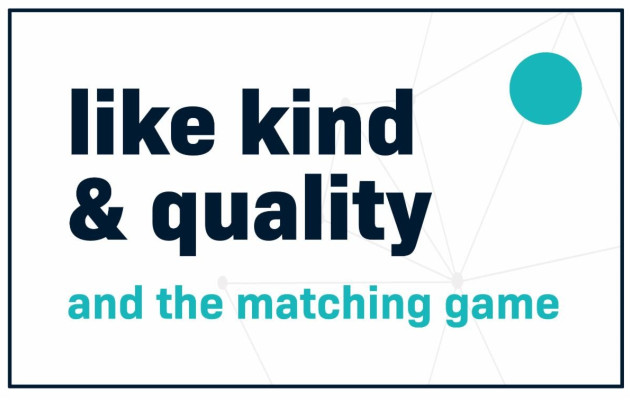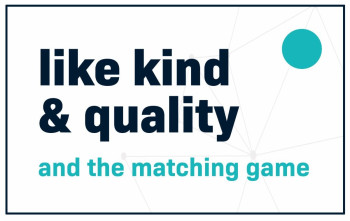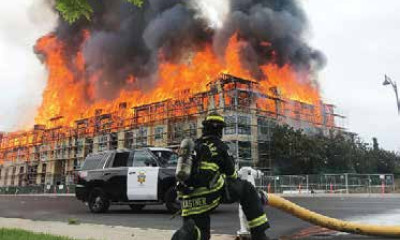A Private Adjuster's Perspective: Like Kind & Quality

Like Kind & Quality & The Matching Game
As a condition of receiving replacement cost benefits, insureds are obligated to replace (or repair) the lost or damaged property with property of like kind and quality and for like use.
The “typical” homeowners policy contains the following replacement provision:
“The replacement cost of that part of the building damaged with material of like kind and quality and for like use” (ISO HO 00 03 03 22; page 17 of 21)
The “typical” commercial policy varies only slightly:
“The cost to replace the lost or damaged property with other property:
- Of comparable material and quality; and
- Used for the same purpose” (ISO CP 00 10 10 12)”
For discussion purposes, we will treat these terms as substantially interchangeable:
- “like kind and quality” and “ comparable material and quality”
- “for like use” and “used for the same purpose”.
Like Kind and Quality:
Exactly what is meant by the phrase “like kind and quality”? Unfortunately, policies do not define this phrase and there are no easy answers. As so often occurs when one interprets and applies the terms of a policy of insurance, IT DEPENDS.
It may depend on how closely the proposed substitution “matches” the original lost property.
It may depend on whether the insurer, when adjusting the loss, decides to be liberal or conservative when applying this requisite standard.
It may depend on how a given state interprets and applies these policy provisions. It may depend on….
A Residential Loss:
Mr. and Mrs. Doe’s 3,000 square foot, 4 bedrooms, 3 baths house is totally destroyed by fire. The Does have lived there for many years having raised 2 children who are now grown and gone. Currently, Mrs. Doe has an elderly mother for whom she provides support. In addition to losing their house, the Does have lost all of their furnishings, personal effects and remaining personal property.
In seeking to recover the full amount of their replacement cost benefits, the Does intend to rebuild or replace their destroyed home with a new 2,000 square foot, 2 bedrooms, 2 baths main dwelling together with a 1,000 square foot, 1 bedroom, 1 bath guest house for Mrs. Doe’s mother.
Will the Does be able to accomplish their wish?
As previously stated, IT DEPENDS.
Insurer A sells a low-cost policy and is extremely restrictive when it comes to claim payouts. Insurer A might very well-and most likely will-deny the Does replacement cost claim arguing that 2 houses is not a “like kind” replacement. One for one and not two for one is “like kind”. Furthermore, 2 houses will not constitute “like use” in that the insured property housed one family (the Does) under one roof.
Insurer B sells a very high-end policy and is extremely liberal when it comes to claim payouts. Insurer B might very well allow the Does replacement cost claim accepting the argument that the replacement remains wholly residential, serving the housing of family members.
The Does seek replacement cost recoveries for their lost personal property. They have submitted an inventory of lost clothing which included Mr. Doe’s claim for six business suits having a replacement cost of $9,000. At the time of the loss, Mr. Doe was retired and found himself no longer in need of business attire. Instead of purchasing replacement suits, he spent $9,000 acquiring sportswear such as hunting, fishing and safari outfits.
Here, Insurer A-being ever stingy-will most probably deny this claim arguing the replacements were neither of “like kind” nor for “like use”.
One could fully expect Insurer B to react differently-accepting the argument that clothing was replaced by clothing.
Of course, Insurer B’s policy is much more expensive than Insurer A’s. But here, the saying “you get what you pay for” becomes quite apropos.
A Commercial Loss:
For twenty years, Mr. Smith owned and operated a 5,000 square foot restaurant valued at $5,000,000. After a fire destroyed the property. Mr. Smith, tired of operating a food facility, is contemplating replacing the destroyed restaurant with a shopping center of the same size and cost. He is also mulling over the idea of substituting a multi-family apartment building for the restaurant.
Will either of these alternatives work for him?
As previously stated, IT DEPENDS.
Here, it depends on how strictly or liberally his insurer applies the “used for the same purpose” standard.
Also, in play, will be the state where the property is located. Each State has jurisdiction over the land within its boundaries and governing laws vary from state to state.
Our low-cost insurer will argue that a shopping center (or a multi-family apartment complex) is not “like” or “used for the same purpose” as a restaurant. The latter sells food while the former sells all kinds of merchandise (or houses people).
Our high-end insurer might very well recognize Mr. Smith’s simple argument that a restaurant is an income producing enterprise just “like” a shopping center or multi-family building.
It must be clearly noted that state court decisions and run the gamut on this issue. Some have allowed substitution of any commercial enterprise for any other; some have not. Some states, when deciding whether an acceptable replacement has occurred, only look at function-residential or commercial-and ignore the source of income; some do not.
The Matching Game:
Similar to, but different from, the “like kind”/”like use” issue is the question of “matching”.
Fire has destroyed the south facing portion of Mr. and Mrs. Green’s cedar shake roof. Matching shingles are unavailable.
The Greens want their entire roof replaced so that every elevation matches as they did in the pre-loss condition.
Their carrier disagrees and offers to replace only the damaged south half of the roof.
What result?
The answer may turn on whether the Greens are insured with Carrier A (restrictive) or Carrier B (expansive).
Or the amount of recovery may be dependent upon governing state law. Various courts have found both options: some state the entire thing should be replaced while others hold that repairs, even if they do not match in their entirety, are acceptable. Some states have statutes directly addressing the issue, while others do not. Other states have attempted to resolve the issue indirectly.
A smattering of examples (cites omitted):
California:
“When a loss requires replacement of items and the replaced items do not match in quality, color or size, the insurer shall replace all items in the damaged area so as to conform to reasonably uniform appearance.”
Query: what is the damaged area? The roof or just the South portion of the roof? What is a “reasonably uniform appearance”? (Please refer tto our July 2023 newsletter articled entitled Tergiversation, Wesel Words, and your Policy).
Arizona:
“The reasonable expectations doctrine for insurance claims states that when insurance terms cannot be understood by the reasonably intelligent consumer, the court will interpret them in light of reasonable expectations of the average insured. Thus, matching can be enforced when consumer reasonably believes the contract allows for it, even when it does not.”
Oregon:
“…When different constructions of a provision are otherwise equally proper, that construction is to be taken which is most favorable to the party in whose favor the provision was made.”
Washington:
“There is another principle applying to contracts of insurance to the effect that if they are so drawn as to require interpretation and fairly susceptible of two different conclusions, the one will be adopted most favorable to the insured; and…strictly construed against the insurer”.
Concluding Remarks:
As can readily be seen, there are no simple and concrete answers to the issues of “like kind” and “like use”, and terms of similar import. Unfortunately, nowhere do policies of insurance define these terms.
Insurers often apply these “standards” in a willy, nilly, arbitrary and capricious way-all with the aim of reducing benefits to their insureds.
How silly and unfair for a carrier to argue that, if an insured lost a medium size shirt, in order to recover a replacement cost benefit, he must replace that exact same shirt even though, over the years, the insured has gained weight and now wears a size large. And given that no carrier would argue such, then how can a carrier argue that one cannot replace pants for shirts? Or hardwood for carpet? etc?
How silly and unfair for a carrier to require an owner of income producing property (e.g. restaurant) to replace with an identical property when there are so many other available income producing properties for the same replacement cost which fit their insureds present needs and desires.
To overcome the fickle and mercurial ways of certain carriers, insureds are truly in need of strong advocacy by professionals who “know the game”. Professionals who understand and can argue common sense definitions, rules and regulations and forcefully present the “reasonable expectations of their clients”.









